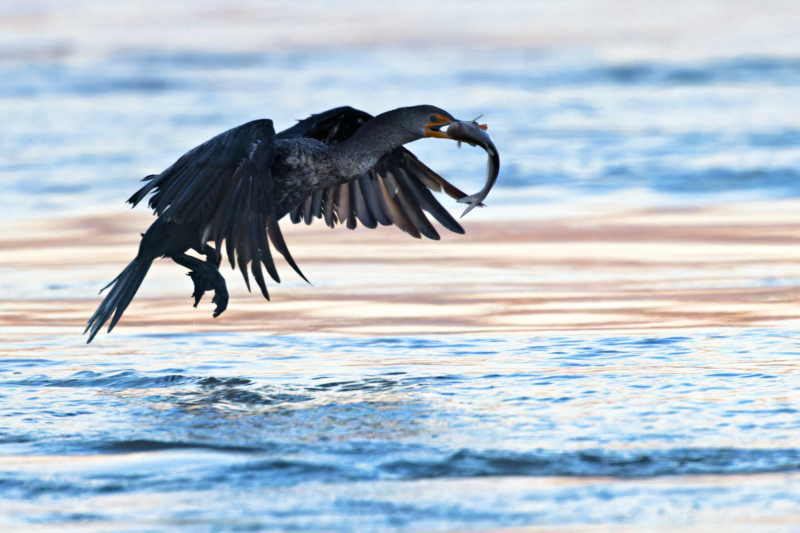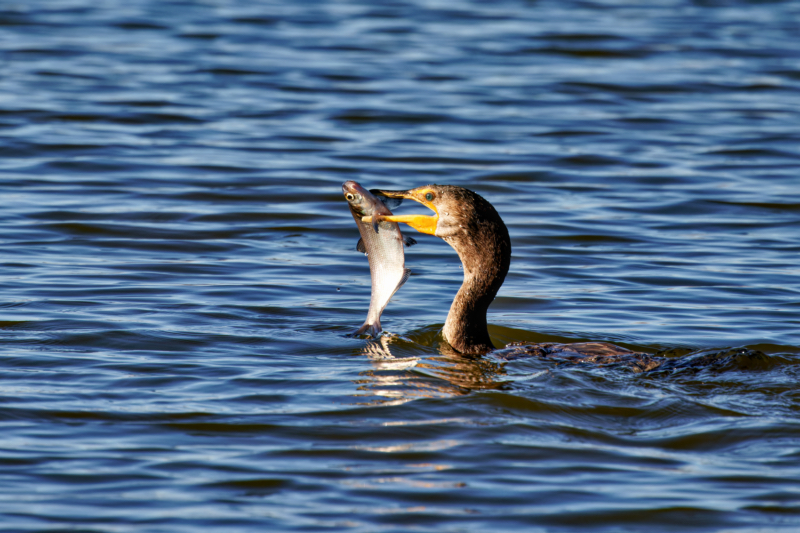Yesterday, I wrote a blog post about “The Catch-and-Release Cormorant Mystery.” Today, I am writing about how Double-crested Cormorants eat fish differently depending on their location. I’ve observed that when I photograph these birds at Kerr Dam in Oklahoma, they sometimes fly with a fish that they’ve caught instead of eating it in the water. I believe this is because of the high number of birds around that try to steal their catch if they try to swallow the fish while still in the water. The main threats are gulls and white pelicans.

In terms of safety, if a cormorant feels threatened by predators or other birds, it may fly away with its catch to avoid being robbed. They may also fly to a higher perch to eat, where they are less vulnerable to attacks.

On the other hand, when I photograph Double-crested Cormorants at Charleston Lake in Charleston, Arkansas, I notice that they surface with their catch and position the fish so that they can swallow it while still in the water. The eagles are nearby, but the cormorants must feel safer eating the fish in the water.
I have never seen one of these birds eating a fish that they have flown away with. It seems to me that the fish would be too dry to swallow after being out of the water that long.
I did some research and discovered the following:
- Short flights: When cormorants take flight with a fish, they typically only travel short distances, often to a nearby perch or rock. This minimizes the time the fish is exposed to air and prevents excessive drying.
- Moist throat pouch: Cormorants have a expandable throat pouch where they temporarily store their catch. This pouch retains some moisture from the captured fish, helping to keep it from drying out completely.
- Maneuvering and positioning: While flying, cormorants may position the fish headfirst in their pouch or beak, allowing them to access the moist gills and eyes for hydration.
- Pre-swallowing adjustments: Before swallowing the fish whole, cormorants may manipulate it in their beak, shaking it to remove excess water and reposition it for easier ingestion.
- Delayed swallowing: In some cases, cormorants may return to the water shortly after catching a fish, dipping their pouch or beak to rehydrate the catch before flying off again.
- Alternative feeding options: If a fish does become too dry for convenient swallowing, cormorants may choose to tear off and eat more moist parts like the eyes, gills, or flesh, leaving the rest behind.
Overall, a combination of these adaptations and behaviors allows Double-crested Cormorants to effectively eat fish even after short flights out of the water. While the fish may not be as fresh as when first caught, they still manage to extract enough moisture and nutrients to sustain themselves.
So, while I might not have directly witnessed a Cormorant eating a fish after flying with it, their resourceful techniques make it a successful strategy for their dietary needs.
